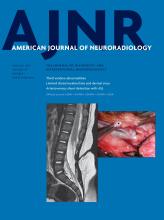Index by author
Zhou, Y.
- FELLOWS' JOURNAL CLUBPediatric NeuroimagingOpen AccessWhite Matter Injury and General Movements in High-Risk Preterm InfantsC. Peyton, E. Yang, M.E. Msall, L. Adde, R. Støen, T. Fjørtoft, A.F. Bos, C. Einspieler, Y. Zhou, M.D. Schreiber, J.D. Marks and A. DrobyshevskyAmerican Journal of Neuroradiology January 2017, 38 (1) 162-169; DOI: https://doi.org/10.3174/ajnr.A4955
Cerebral palsy has been predicted by analysis of spontaneous movements in the infant termed “General Movement Assessment.” The authors evaluated the utility of General Movement Assessment in predicting adverse cognitive, language, and motor outcomes in very preterm infants and attempted to identify brain imaging markers associated with both adverse outcomes and aberrant general movements in 47 preterm infants using MRI volumetric analysis and DTI. Nine infants had aberrant general movements and were more likely to have adverse neurodevelopmental outcomes, compared with infants with normal movements. In infants with aberrant movements, Tract-Based Spatial Statistics analysis identified significantly lower fractional anisotropy in widespread WM tracts. They conclude that aberrant general movements at 10–15 weeks' postterm are associated with adverse neurodevelopmental outcomes and specific white matter microstructure abnormalities for cognitive, language, and motor delays.
Zins, M.
- FELLOWS' JOURNAL CLUBAdult BrainYou have accessIntracranial Arteriovenous Shunting: Detection with Arterial Spin-Labeling and Susceptibility-Weighted Imaging CombinedJ. Hodel, X. Leclerc, E. Kalsoum, M. Zuber, R. Tamazyan, M.A. Benadjaoud, J.-P. Pruvo, M. Piotin, H. Baharvahdat, M. Zins and R. BlancAmerican Journal of Neuroradiology January 2017, 38 (1) 71-76; DOI: https://doi.org/10.3174/ajnr.A4961
Ninety-two consecutive patients with a known (n = 24) or suspected arteriovenous shunting (n = 68) underwent DSA and brain MR imaging, including arterial spin-labeling/SWI and conventional angiographic MR imaging. DSA showed arteriovenous shunting in 63 of the 92 patients. Interobserver agreement was excellent. In 5 patients, arterial spin-labeling/SWI correctly detected arteriovenous shunting, while the conventional angiographic MR imaging did not. The authors conclude that the combined use of arterial spin-labeling and SWI may be an alternative to contrast-enhanced MRA for the detection of intracranial arteriovenous shunting.
Zuber, M.
- FELLOWS' JOURNAL CLUBAdult BrainYou have accessIntracranial Arteriovenous Shunting: Detection with Arterial Spin-Labeling and Susceptibility-Weighted Imaging CombinedJ. Hodel, X. Leclerc, E. Kalsoum, M. Zuber, R. Tamazyan, M.A. Benadjaoud, J.-P. Pruvo, M. Piotin, H. Baharvahdat, M. Zins and R. BlancAmerican Journal of Neuroradiology January 2017, 38 (1) 71-76; DOI: https://doi.org/10.3174/ajnr.A4961
Ninety-two consecutive patients with a known (n = 24) or suspected arteriovenous shunting (n = 68) underwent DSA and brain MR imaging, including arterial spin-labeling/SWI and conventional angiographic MR imaging. DSA showed arteriovenous shunting in 63 of the 92 patients. Interobserver agreement was excellent. In 5 patients, arterial spin-labeling/SWI correctly detected arteriovenous shunting, while the conventional angiographic MR imaging did not. The authors conclude that the combined use of arterial spin-labeling and SWI may be an alternative to contrast-enhanced MRA for the detection of intracranial arteriovenous shunting.








